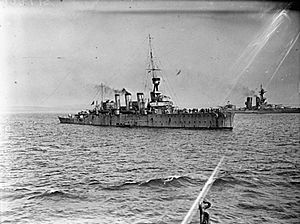HMS Birkenhead (1915) facts for kids
 |
|
Quick facts for kids History |
|
|---|---|
| Name | Antinavarchos Kountouriotis |
| Namesake | Pavlos Kountouriotis |
| Builder | Cammell Laird, Birkenhead, England |
| Laid down | 21 March 1914 |
| Launched | 18 January 1915 |
| Fate | Sold to the United Kingdom, 1915 |
| Namesake | Birkenhead |
| Acquired | 1915 |
| Commissioned | May 1915 |
| Renamed | HMS Birkenhead |
| Fate | Sold for scrap, 26 October 1921 |
| General characteristics (as built) | |
| Class and type | Town-class light cruiser |
| Displacement | 5,235 long tons (5,319 t) |
| Length |
|
| Beam | 49 ft 10 in (15.2 m) |
| Draught | 15 ft 3 in (4.65 m) (mean) |
| Installed power |
|
| Propulsion | 4 × shafts; 3 × Parsons steam turbines |
| Speed | 25.5 kn (47.2 km/h; 29.3 mph) |
| Complement | about 500 |
| Armament |
|
| Armour |
|
HMS Birkenhead was a type of warship called a light cruiser. She was one of two ships originally ordered by the Greek Navy in 1914. Her first name was Antinavarchos Kountouriotis, named after a Greek Vice Admiral. The ship was built by Cammell Laird in England.
Even after World War I started in August 1914, Greece continued to pay for the ship. But in 1915, the British government bought both cruisers. They then joined the Royal Navy, which is the British navy.
Contents
Ship Design and Features
The Birkenhead was based on a British ship design called the Birmingham-class. However, the Greek navy wanted different weapons for their ships.
Special Guns for the Ship
The Greeks chose a new type of gun called the BL 5.5-inch (140 mm) Mk I gun. These guns were made by the Coventry Ordnance Works. They were lighter than the usual 6-inch (152 mm) guns. This meant the ship could carry ten of these guns instead of nine. Even though their shells were a bit lighter, these guns could fire faster.
The Greeks also wanted two 12-pounder anti-aircraft guns. But these guns were still being developed in 1915. So, the ship got two 3-pounder guns instead. These were placed on special mounts that could aim high into the sky.
Ship's Size and Power
The Birkenhead was about 456 feet 6 inches (139.1 m) long. That's longer than a football field! It was 49 feet 10 inches (15.2 m) wide. The ship weighed about 5,235 long tons (5,319 t) when it was ready for normal use.
To make the ship move, it had twelve Yarrow boilers. These boilers powered Parsons steam turbines. These turbines turned four propeller shafts. The ship could reach a speed of 25.5 knots (47.2 km/h; 29.3 mph), which is quite fast for a warship. It used both fuel oil and coal to power its engines.
Weapon Placement
Two of the main 5.5-inch guns were placed in the middle of the ship, one at the front and one at the back. The other eight guns were placed along the sides of the ship. All these guns had gun shields to protect the sailors using them.
The ship also had two Vickers 3-pounder (47 mm) anti-aircraft guns. These were used to shoot down enemy aircraft. For underwater attacks, the ship had two 21-inch (533 mm) torpedo tubes. These tubes launched torpedoes from below the waterline.
Ship's Service and Battles
The ship's construction began on March 27, 1914. Even though World War I had started, Greece kept paying for the two cruisers. The Antinavarhos Kountoriotis was launched on January 18, 1915.
As the war continued, the British navy decided to buy the two ships. So, Antinavarhos Kountouriotis was renamed Birkenhead. She was finished and ready for duty in July 1915.
Joining the Fleet
Like her sister, Chester, Birkenhead joined the 3rd Light Cruiser Squadron. This squadron was part of the Grand Fleet, a large group of British warships.
On September 26, 1915, Birkenhead helped rescue people from another ship. The ship, named Caribbean, was in trouble during bad weather. Birkenhead rushed to help and saved almost all of Caribbean's crew. The Caribbean sank the next morning.
Battle of Jutland
From May 31 to June 1, 1916, Birkenhead and Chester both fought in the Battle of Jutland. This was one of the biggest naval battles of World War I. Birkenhead survived this huge battle.
After the war, Birkenhead was no longer needed. She was sold for scrap on October 26, 1921. This means the ship was taken apart for its materials.

